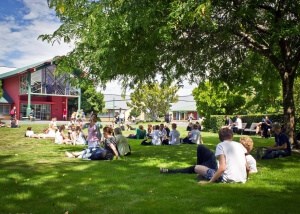 When the Hawke’s Bay Community College opened its doors for vocational and community education in 1975, few could have envisaged its transformation into EIT – one of New Zealand’s leading tertiary educators.
When the Hawke’s Bay Community College opened its doors for vocational and community education in 1975, few could have envisaged its transformation into EIT – one of New Zealand’s leading tertiary educators.
The genesis of EIT was Margaret Hetley’s bequest of land that was formerly part of the Ōtatara Pa site, south of Taradale.
Hilda Margaret Hetley (1889-75) had graduated with a Master of Arts from Cambridge University and she wanted a tertiary institution for Hawke’s Bay. She made her bequest for a campus to honour her late husband, Frederic St Arnaud Hetley, and also to mark the provincial centennial of Hawke’s Bay in 1958.
The establishment of the Ōtatara Children’s Centre and the Otatara bookshop in 1977 made study an easier option for many.
In 1985, the first computers were set up on campus to support student learning.
The region’s thriving tertiary educator was renamed Hawke’s Bay Polytechnic in 1986. Nursing training had started five years earlier with 20 full-time staff teaching 54 first-year students, and in 1989 Māori studies launched at Te Manga Māori, now better known as the much-extended Te Ūranga Waka.
The Twist Library opened in 1993, by which time five degree programmes were being jointly offered with Waikato and Massey universities.
Learning Skills and English as a Second Language centres were established the following year to support a growing international student roll.
In 1996, the institution’s name changed to Eastern Institute of Technology and the Bachelor of Nursing was launched as EIT’s first own degree.
By the late 1990s, the roll had increased to 2000 equivalent full-time students. New bachelor degrees encompassed business studies, computing systems, Māori studies, visual arts and design, viticulture and wine science.
Study options continued to expand into the early 2000s, with the addition of bachelor degrees for recreation and sport and applied social sciences, a master’s degree in nursing, an honours’ degree for Māori studies and a diploma in early childhood teaching.
In 2004, a third of EIT students were enrolled in degree programmes. Margaret Hetley’s vision for a regional institution that conferred degrees and postgraduate degrees was being realised.
When EIT Hawke’s Bay merged with Tairāwhiti Polytechnic in Gisborne in 2011, it boosted the roll to 11,000 students.
Maintaining its focus on developing programmes that meet the wide-ranging needs of its communities, EIT now offers 13 degrees and masters and other postgraduate programmes as well as a range of certificates and diplomas encompassing everything from trades, health and agriculture through to applied sciences.
New Zealand’s largest regionally-based Trades Academy opened on the Hawke’s Bay campus in 2012. That year also saw tablets, laptops and cellphones connecting into EIT’s new wifi service.
Having developed its research capabilities over recent years, EIT supports its communities in undertaking applied research projects for local industries and community organisations. It is currently ranked second in the Performance-Based Research Fund ranking for the ITP sector.
The total economic impact of the activities of EIT and its students on the Hawke’s Bay economy was $71.9 million in GDP in 2015. And in that year, the institute employed 910 equivalent full-time staff.
EIT celebrated 40 years last year with 130-plus postgraduate, degree, diploma and certificate level programmes, reflecting its progress as one of New Zealand’s most highly regarded tertiary educators.
